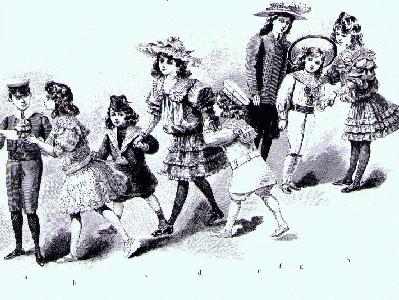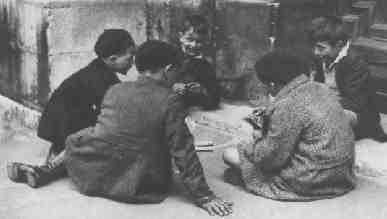
French Boys Clothes Chronology: 20th Century--First Half

Figure 1.--This 1906 magazine illustration shows a cross section of French children's clothes a little after the turn of the century. Note that the three youngest boys all have long curled shoulder length hair. The first group shows two older children, probably about 11-13. Note the boy's military-style cap, stiff Eton collar, bow, knee pants, and long stockings. The second group is less obvious as the long hair suggests the two younger children are girls.
|
|
Fashions changes occurred continually in the 20th century. It is often possible to date an image by decade based on clothing styles, although fashion overlaps make it impossible to do this with any precession. Despite the changes each decade, there were many similarities during the two half centuries. There was still considerable formality in the early-20th century. Even younger children were often dressed formally. And there were pronounced social class differences. This commonly was expressed in the qukity and variety of garments as well as styles. Working-class children and many middle-class children commonly had very limited wardrobes. Children had two sort of garments: some for week-day wear and a best ouitfit for Sunday wear.
The school-week-clothes normaly were changed each week, the Monday or the Friday. The underclothes were changed the Sunday and Thursday. This was becuse clothes were relatively expensive and laundry without washing machines was a drugery for mother. There were no classes Thursday and Sunday. Hollyday were in July and August.
They had many fetes whitout school. n the cities, work for children less 13 years was forbidden. In the country the children could help their parents on the farm. The tragedy of World War I had a fundamental impact on France and other European countries. One was formality. We see much less formality after the war, although suits were still quite common. One convention remained constant in tht boys still wore shortebed-length pants. Before the war, knee pants were common and short pants were common after the war. The shoetrs were at first knee length, but gradually got shorter. Boys in the first half of the century usually wote knee pants or shory pants. Older boys nmight wear knickers. Many boys got long pants for the first time when he did his First Communion at avout ahe 12 years. The long pants were usually with a new suit for the ceremony. But other than this he commonly wore short ants for school and casual play wear. So except for formal occassions, little changed. Boys might wear shorts until they were 14-15 years old or in some families even longer. Here social class was a factor. Working-class boys often began wearing short pnts before middle-class and upper-class boys. A factor here was that in the early-20th century, Children were smaller and tended to look younger and they were dressed in more juvenil fashions. Mother took on a greater role in family life because so many men were lost in the War. This was probably a factor in popular juvenile styles like rompers, blouses, and short pants. Children did not mature and experience puberty as rapidly as they do today. Girls did not begin to be young ladies until after 14 years, today 11 years old is more common. Boys began to experience their voices breaking at about 14 years of age, often not until at 15 years. Today it is more like 12 years. The difference seems to be dietary. Such changes also affect a child's outlook and thinking and how he wants to dress.
The French look back on the early 20th century with great affection. The yeats before World War I (1900-14) are called "La belle époque". HBC still has limited information on French boys' clothing during this period. I'd be interested in any details visitors to this page may have. Available
information suggests that smocks were commonly worn by boys. Images on the Renoir family and
Zola family at around the turn of the family show the children commonly wore smocks. Renoir often painted his children in smocks. Zola's son Jacques wore smocks even when he was 8 or 9 years old. It is not clear to me when the boys would wear their smocks nor do I know what they thought about smocks. They seemed to have been commonly worn around the home, but they also appear in outings to the park dressed in smocks. And of course boys wore blue smocks to school. Other popular outfits appear to be
sailor suits and above the knee knickers. A well dressed boy appears to have always worn a sailor hat or a variety of stylish caps. A friend tells me that early Life Magazine articles had some interesting images of European children showing period clothes. I think in 1917-1918 they ran a series of articles on French children
who had lost their fathers in the War. The magazine I think was asking for donations to help these families. The series contained lots of pictures of these, sadly mostly young, fatherless children. If anyone has
access to a good University library, these Life Magazine images should be available. There apparently was a variety of boys clothes pictured. Advertisers in the early 20th century began using images of children and their characteristic dress to market products.

Figure 2.--French boys in the 1930s and early 1940s still commonly wore berets. I'm not sure just when this photograph was taken. Notice that this photograph taken during the fall or winter shows the boys still wearing short pants under their coats.
|
|
Little boys no longer commonly wore dresses. French mothers, however, did adapt a number of styles for such as modified Fautleroy suits with short shirts, white kneesocks, and strap shoes. These styles were mostly for little boys, but some older boys wore them for special occasions. It is unknown to what extent such outfits were worn. Most of the photograhps
I have seen come from modeled post cards, rather than actual family photographs. French fashions during this period may reflect child raising practices. A whole generation of French boys were wiped out in World War I. I can see why boys born after that War were cherished by their parent and grandparents. French boys in the 1920s were outfitted in the new short pants style. I'm not sure what the boys thought of the new style. Certainly not
having to wear long stockings in the summer must have been more comfortable. French short pants by the l930s were generally worn shorter than in England,
often well above the knees, and not as baggy. French boys, even older boys, commonly wore shorts during the 1920s, 1930s, and 1940s. Younger boys might wear short pants all year round, including the winter--but with knee socks. Some mothers might buy long pants for winter wear. Most boys, however, mostly wore shorts. Formal short pants suits were worn with knee socks, but ankle socks were often worn on more casual occasions and were more common than in England. Short pants and knickers were widely worn by French boys in the 1920s and 30s. Boys like men still commonly wore hats or caps during the 1920s-40s. The most common head gear for French boys were berets. As common as they were during this period, they passed out of fashion for boys by the 1950s.
HBC

Navigate the Boys' Historical Clothing Web Site:
[Introduction]
[Activities]
[Biographies]
[Chronology]
[Clothing styles]
[Countries]
[Essay]
[Bibliographies]
[Contributions]
[FAQs]
[French glossary]
[Images]
[Links]
[Registration]
[Tools]
[Boys' Clothing Home]
Navigate the Boys' Historical Clothing French pages:
[Return to the Main French 20th century chronology page]
[Return to the Main French chronology page]
[Return to the Main French page]
[French choirs]
[French school uniforms]
[French school smocks]
[French royalty]
[French sailor suits]
[French scout uniforms]
[Difficult French images]
[French art]
[French ethnics]
[French postcards]
[French catalogs]
Created: 4:24 PM 2/11/2016
Last updated: 4:24 PM 2/11/2016




